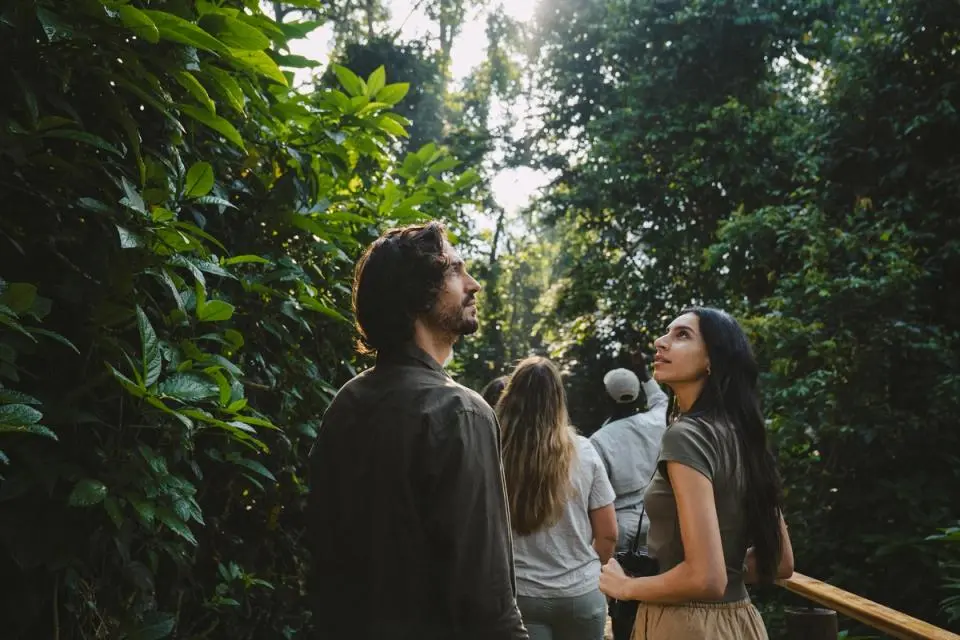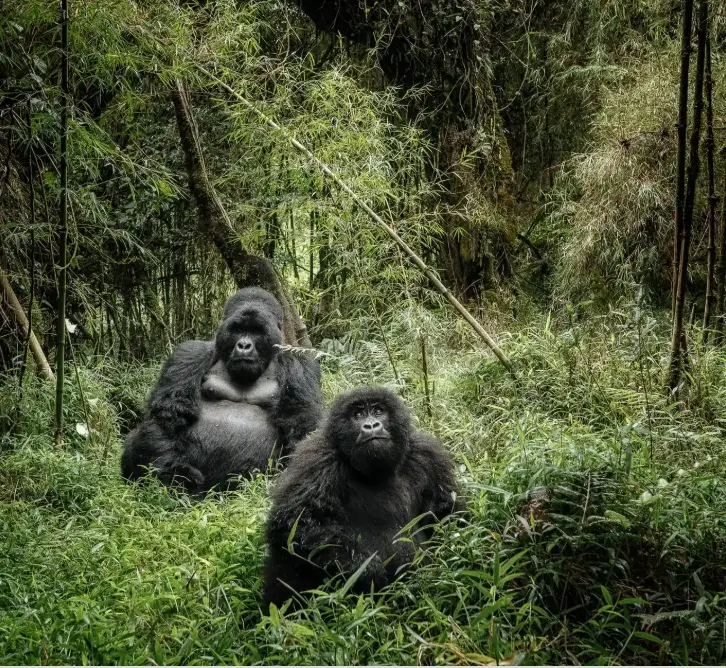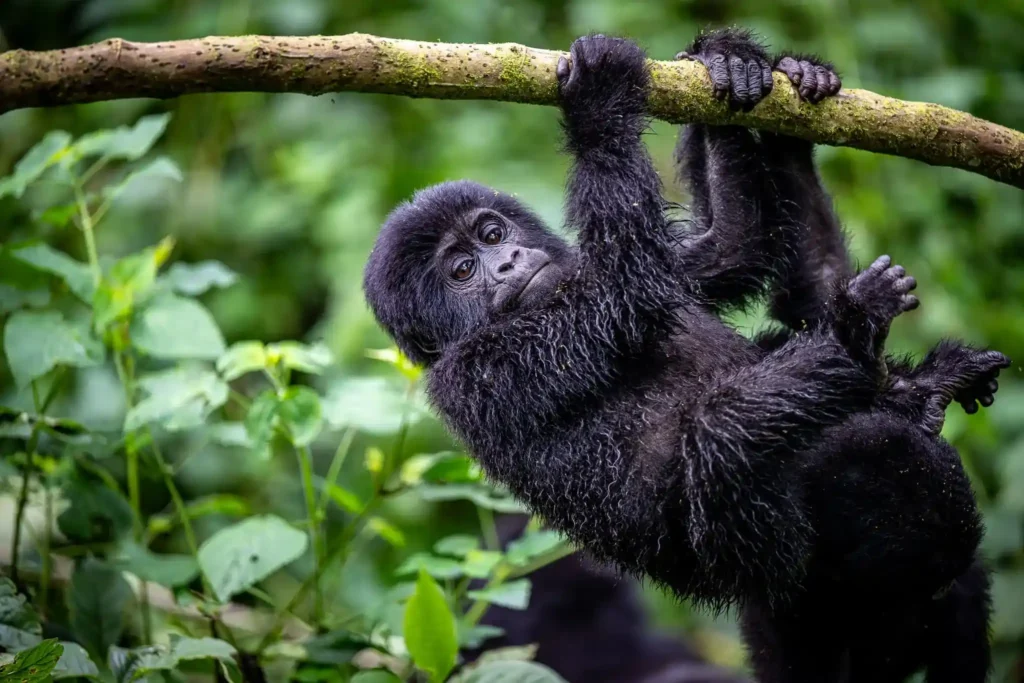Mountain gorilla trekking is one of Africa’s most unforgettable adventures, available only in Uganda, Rwanda, and Congo. But Uganda offers something truly unique: the Gorilla Habituation Experience—the only one of its kind in the world.
Instead of the standard one-hour visit, this experience allows you to spend up to four hours with a semi-habituated gorilla family as they grow used to human presence.
It takes place deep in the Rushaga region of Bwindi Impenetrable Forest, alongside expert trackers and researchers. It’s a more immersive, exclusive, and active encounter—offering rare insight into gorilla behavior, supporting vital conservation, and giving you a once-in-a-lifetime connection with these endangered primates.
Gorillas are some of the smartest animals on Earth.
They can use tools, show emotions like laughter and sadness, and even learn simple sign language—just like humans. In fact, they share about 98% of our DNA. Gorillas live in close family groups, usually led by a powerful adult male called a silverback, who protects the group, which can have up to 30 members.
Because mountain gorillas are endangered and so closely related to us, they are carefully watched and studied by conservationists. But before researchers and tourists can safely be around them, the gorillas need to feel comfortable with people. That’s where gorilla habituation comes in.
Gorilla habituation is the slow and gentle process of getting a wild gorilla family used to humans. This helps protect both the gorillas and the people who visit them.
Only gorilla families that are fully habituated are visited by tourists for regular gorilla trekking. Those that are not used to people are left alone in the wild. The habituation process is done by a skilled team of trackers, researchers, park rangers, and conservationists. They visit the same gorilla family every day for 2 to 3 years, gradually earning their trust.



What is The Gorilla Habituation Experience Really Like?
Uganda offers a truly rare and exciting chance—not just to see mountain gorillas, but to actually join the team that helps them get used to people. This special experience lets you track a semi-habituated gorilla family.
These gorillas know the regular trackers but are still learning to accept new human faces—like yours.
Every day, for about three years, trackers visit the same gorilla group to slowly build trust. By the time you join the experience, the gorillas are familiar with humans but still a little cautious. Your visit helps them continue that process.
Unlike regular gorilla trekking—where the trackers guide you directly to the gorillas—this experience is more of an adventure. You will start your trek from where the group was last seen the day before. With the help of expert trackers, you will move through dense forest, looking for clues like knuckle prints in the mud, broken branches, or leftover food to find their new nesting spot.
Gorillas build new nests every night and move often to find fresh food. As you track them, you will also help the team collect important samples like hair and dung, which are used to monitor their health and numbers.
Once you find the gorillas, the goal is to follow them calmly and stay within about 7 meters (23 feet). But don’t expect them to sit still! These semi-habituated gorillas are more active and unpredictable than fully habituated ones. They climb, move fast, and can disappear into thick vegetation without warning.
The trek can be physically demanding—steep, muddy, and wild. It’s more like a jungle workout than a casual nature walk, so it’s best for those who are reasonably fit and ready for adventure. Because they are not yet fully habituated, these gorillas may act more boldly.
A silverback might charge, but this is usually just a warning, not an attack. Trackers will guide you on how to stay safe—stay calm, crouch down, and avoid direct eye contact. It can be intense—but unforgettable.
When the gorillas stop, so do you. You will quietly copy their behavior to help them feel safe.
That might mean crouching, pretending to eat leaves, or even communicate in gorilla language—a range of vocalizations with specific meanings.
To have a gorilla respond to your deep, throaty rumble—a sound that signifies contentment—is nothing short of spine-tingling. It’s not just a wildlife encounter; it’s a moment of profound connection.
Where to Go for the Gorilla Habituation?

Gorilla Habituation Experience is only available in Uganda, and it takes place in the Rushaga region of Bwindi Impenetrable Forest National Park—a remote and beautiful area known for its rich biodiversity. While regular gorilla trekking is offered in Uganda, Rwanda, and the Democratic Republic of Congo, the habituation experience is unique to Uganda.
It’s more exclusive and immersive, with only four visitors allowed per day to join a group of expert trackers and researchers. The best time to visit is during Uganda’s dry seasons—from mid-December to March and June to October—when forest trails are easier to hike and the weather is more reliable.
Gorilla Habituation Experience Permit
As of July 2025, the permit for the Gorilla Habituation Experience costs $1,500 USD per person. Because only four permits are issued daily for each gorilla family under habituation, it’s important to book well in advance. The permit includes park entry, expert guides and trackers, 24-hour security, and supports ongoing gorilla conservation efforts—such as research, veterinary care, community projects, and park management. Participants must be at least 15 years old to join the experience. For comparison, a regular gorilla trekking permit costs around $800 USD for foreign visitors.
What to Pack for the Gorilla Habituation Experience
- Waterproof hiking boots with good ankle support and grip. To prevent blisters, wear comfortable walking socks and break in your boots before the trip.
- Lightweight, breathable, waterproof jacket and trousers, plus long-sleeved shirts. Long sleeves and pants protect against insect bites and keep you warm if the weather changes.
- Gardening gloves or lightweight gloves to protect your hands while moving through thick vegetation.
- Hat and sunglasses to shield you from the sun.
- A lightweight backpack big enough to carry your lunch, reusable water bottle, extra layers, snacks, and essentials like sunscreen, insect repellent, after-sun lotion, bite relief cream, and lip balm.
- Camera with extra batteries and a waterproof cover to capture every moment.
Where to Stay Near Rushaga, Bwindi
Near the Rushaga area of Bwindi Impenetrable Forest, you’ll find some fantastic places to stay, many offering stunning mountain views and locally inspired traditional architecture. For a luxurious experience, consider Clouds Mountain Gorilla Lodge.
This elegant lodge combines modern comforts with beautiful wood and stone design, creating a peaceful and stylish retreat. If you prefer something more affordable but still comfortable and welcoming, great options include Mutanda Lake Resort, Chameleon Hill Lodge, Kiho Gorilla Lodge, Ichumbi Lodge, and Lake Mulehe Safari Lodge.
These lodges provide excellent hospitality and a chance to enjoy the natural beauty of the area without breaking the bank. You may also like, 13 best value lodges in Bwindi Impenetrable National Park
How to get to Bwindi Impenetrable National Park
Bwindi Impenetrable National Park is located in southwest Uganda and can be reached by air or road. Most travelers arrive in Uganda through Entebbe International Airport, the country’s largest airport near Kampala.
If you’re short on time, flying is the quickest option. There are two main airstrips serving the Bwindi region: Kisoro Airstrip, which serves the Rushaga and Nkuringo sectors, and Kihihi Airstrip, which serves the Buhoma and Ruhija sector. Both airstrips offer daily flights from Entebbe, with a flight time of about 1.5 hours.
For those who prefer to drive, the journey from Kampala to Bwindi typically takes between 8 and 10 hours, depending on road conditions. Many travelers break up the trip with stops at other exciting destinations like Kibale Forest National Park, where you can track chimpanzees, Queen Elizabeth National Park, known for its classic safari experience, and Murchison Falls National Park, where you can enjoy a boat safari on the Nile River. If you are coming from Rwanda, the drive from Kigali to Rushaga takes about 3 to 3.5 hours, making Bwindi a convenient gorilla trekking destination for visitors in the region.






